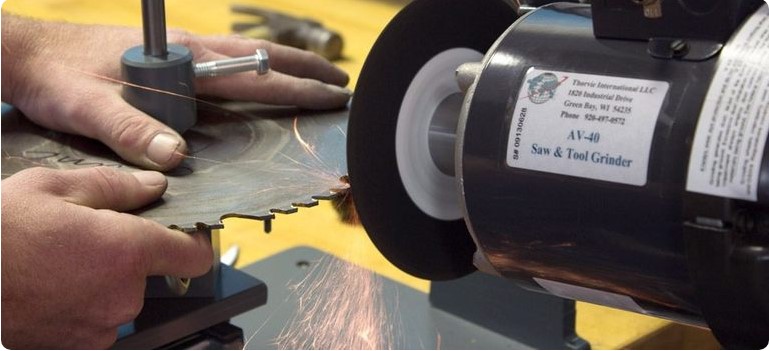Table of Contents
A 12-inch miter saw is a woodworking powerhouse, but its performance is heavily reliant on the condition of its blades. Dull or poorly-maintained blades can lead to imprecise cuts, splintering, and reduced overall efficiency. In this comprehensive guide, we’ll explore the art of sharpening and maintaining your 12-inch miter saw blades to ensure they remain sharp and ready for any woodworking project.
Understanding Miter Saw Blades
Before diving into sharpening and maintenance, it’s essential to understand the types of miter saw blades and their applications. Common blade types include:
- Crosscut Blades: Designed for clean, smooth cuts across the wood grain.
- Rip Blades: Ideal for cutting with the wood grain.
- Combination Blades: Versatile blades suitable for both crosscutting and ripping.
- Fine-Tooth Blades: Deliver precise and clean cuts.
- Coarse-Tooth Blades: Designed for rough cuts and speed.
Identifying the right blade for your project is the first step in ensuring optimal performance.
Signs of Dull Blades
Recognizing the signs of dull blades is crucial for timely maintenance. Common indicators include:
- Burn Marks: Overheating and burning of wood during cuts.
- Splintering: Jagged edges and splintering instead of clean cuts.
- Reduced Cutting Speed: Blades struggling to cut efficiently.
- Excessive Vibrations: Increased vibrations during cutting.
- Inaccurate Cuts: Cuts deviating from the intended angles.
If you notice any of these signs, it’s time to address your blade’s condition.
Tools and Materials
Gather the necessary tools and materials for blade sharpening and maintenance:
- Safety Gear: Safety glasses, hearing protection, and gloves.
- Blade Sharpener: A suitable blade sharpener or sharpening kit.
- Cleaning Supplies: Solvents, brushes, and rags for cleaning.
- Lubricant: Lubricating oil or spray.
- Workbench: A stable work surface with clamps for securing the blade.
- File or Honing Guide: For manual sharpening, if preferred.
Ensuring you have the right equipment is essential for a successful sharpening process.
Safety Precautions
Before sharpening or maintaining your miter saw blades, prioritize safety:
- Protective Gear: Wear safety glasses, hearing protection, and gloves.
- Well-Ventilated Area: Work in a space with good ventilation to minimize fumes.
- Stable Work Surface: Ensure your workbench is stable and securely clamped.
- Follow Manufacturer Guidelines: Adhere to the manufacturer’s instructions for blade removal and maintenance.
Safety should always be the first consideration when working with sharp tools.
Step-by-Step Guide: Blade Sharpening
Sharpening your 12-inch miter saw blades is a systematic process:
- Blade Removal: Safely remove the blade from the miter saw.
- Cleaning: Remove dirt, resin, and debris from the blade using a solvent and brush.
- Securing the Blade: Use a blade sharpener or a manual sharpening tool to secure the blade in place.
- Sharpening Process: Follow the sharpener’s instructions or use a file to sharpen the teeth, maintaining the original angle.
- Balancing: Ensure the blade is balanced to prevent vibrations during use.
- Reassembly: Reattach the sharp blade to your miter saw.
A sharp blade will significantly improve cutting performance and precision.

Step-by-Step Guide: Blade Maintenance
Maintaining your miter saw blades regularly is essential for prolonging their lifespan:
- Regular Cleaning: After each use, clean the blade to remove sawdust, resin, and debris.
- Lubrication: Apply lubricant to the blade’s moving parts to reduce friction.
- Inspect Teeth: Periodically inspect the blade’s teeth for any damage or dullness.
- Retensioning: Check for proper blade tension to ensure it runs smoothly.
Routine maintenance ensures that your blades stay in top shape for longer periods.
DIY vs. Professional Sharpening
Deciding whether to sharpen your blades yourself or seek professional sharpening services depends on your skill level and preference. DIY sharpening can save costs, but professional services may guarantee precision. Consider your comfort level and the specific needs of your projects when making this choice.
Troubleshooting Blade Issues
Sometimes, despite proper maintenance, you may encounter issues with your miter saw blades. Common problems include:
- Uneven Cuts: Adjust the blade or check for a bent arbor.
- Excessive Vibration: Ensure the blade is balanced and properly secured.
- Excessive Noise: Clean the blade and check for damaged teeth.
- Overheating: Slow down your cutting speed and ensure the blade is sharp.
Addressing these problems promptly can lead to smoother, safer cutting experiences.
Extending Blade Life
To maximize the lifespan of your 12-inch miter saw blades, consider the following tips:
- Proper Storage: Store blades in a dry, clean place to prevent corrosion.
- Use the Right Blade: Select the appropriate blade type for each task.
- Reduce Cutting Speed: Slower, controlled cuts reduce blade wear.
- Keep Clean Workpieces: Minimize contact with nails or other hard materials.
By following these tips, you’ll extend the life of your blades and ensure consistent cutting performance.
Conclusion
Mastering the art of sharpening and maintaining your 12-inch miter saw blades is a valuable skill for any woodworker. Regular maintenance and timely sharpening not only ensure safer woodworking but also deliver cleaner, more precise cuts. Remember to prioritize safety, choose the right equipment, and follow manufacturer guidelines. With sharp and well-maintained blades, you’ll tackle your woodworking projects with confidence and efficiency.